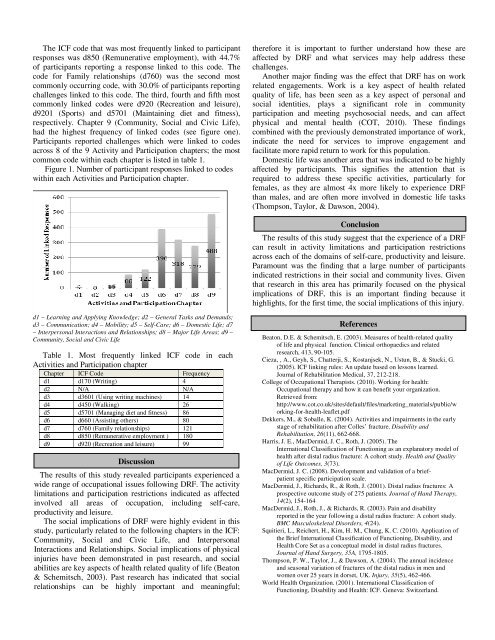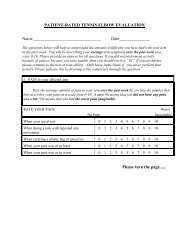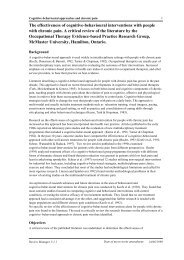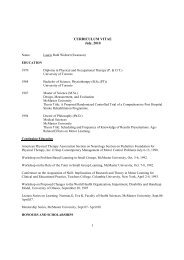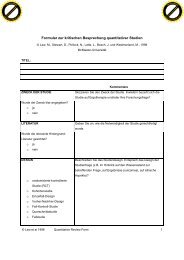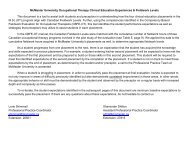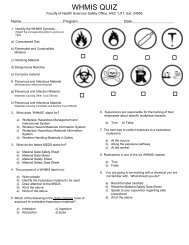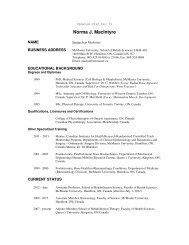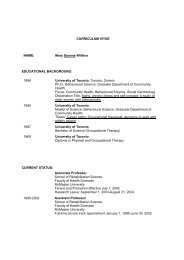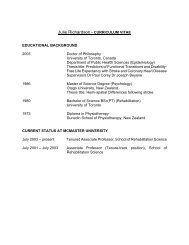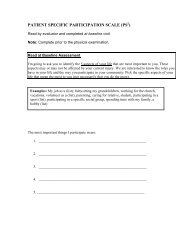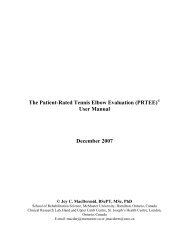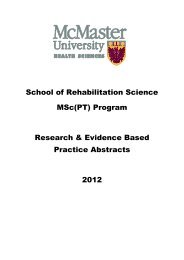Evidence Based Practice Symposium - McMaster University
Evidence Based Practice Symposium - McMaster University
Evidence Based Practice Symposium - McMaster University
Create successful ePaper yourself
Turn your PDF publications into a flip-book with our unique Google optimized e-Paper software.
The ICF code that was most frequently linked to participant<br />
responses was d850 (Remunerative employment), with 44.7%<br />
of participants reporting a response linked to this code. The<br />
code for Family relationships (d760) was the second most<br />
commonly occurring code, with 30.0% of participants reporting<br />
challenges linked to this code. The third, fourth and fifth most<br />
commonly linked codes were d920 (Recreation and leisure),<br />
d9201 (Sports) and d5701 (Maintaining diet and fitness),<br />
respectively. Chapter 9 (Community, Social and Civic Life),<br />
had the highest frequency of linked codes (see figure one).<br />
Participants reported challenges which were linked to codes<br />
across 8 of the 9 Activity and Participation chapters; the most<br />
common code within each chapter is listed in table 1.<br />
Figure 1. Number of participant responses linked to codes<br />
within each Activities and Participation chapter.<br />
d1 – Learning and Applying Knowledge; d2 – General Tasks and Demands;<br />
d3 – Communication; d4 – Mobility; d5 – Self-Care; d6 – Domestic Life; d7<br />
– Interpersonal Interactions and Relationships; d8 – Major Life Areas; d9 –<br />
Community, Social and Civic Life<br />
Table 1. Most frequently linked ICF code in each<br />
Activities and Participation chapter<br />
Chapter ICF Code Frequency<br />
d1 d170 (Writing) 4<br />
d2 N/A N/A<br />
d3 d3601 (Using writing machines) 14<br />
d4 d450 (Walking) 26<br />
d5 d5701 (Managing diet and fitness) 86<br />
d6 d660 (Assisting others) 80<br />
d7 d760 (Family relationships) 121<br />
d8 d850 (Remunerative employment ) 180<br />
d9 d920 (Recreation and leisure) 99<br />
Discussion<br />
The results of this study revealed participants experienced a<br />
wide range of occupational issues following DRF. The activity<br />
limitations and participation restrictions indicated as affected<br />
involved all areas of occupation, including self-care,<br />
productivity and leisure.<br />
The social implications of DRF were highly evident in this<br />
study, particularly related to the following chapters in the ICF:<br />
Community, Social and Civic Life, and Interpersonal<br />
Interactions and Relationships. Social implications of physical<br />
injuries have been demonstrated in past research, and social<br />
abilities are key aspects of health related quality of life (Beaton<br />
& Schemitsch, 2003). Past research has indicated that social<br />
relationships can be highly important and meaningful;<br />
therefore it is important to further understand how these are<br />
affected by DRF and what services may help address these<br />
challenges.<br />
Another major finding was the effect that DRF has on work<br />
related engagements. Work is a key aspect of health related<br />
quality of life, has been seen as a key aspect of personal and<br />
social identities, plays a significant role in community<br />
participation and meeting psychosocial needs, and can affect<br />
physical and mental health (COT, 2010). These findings<br />
combined with the previously demonstrated importance of work,<br />
indicate the need for services to improve engagement and<br />
facilitate more rapid return to work for this population.<br />
Domestic life was another area that was indicated to be highly<br />
affected by participants. This signifies the attention that is<br />
required to address these specific activities, particularly for<br />
females, as they are almost 4x more likely to experience DRF<br />
than males, and are often more involved in domestic life tasks<br />
(Thompson, Taylor, & Dawson, 2004).<br />
Conclusion<br />
The results of this study suggest that the experience of a DRF<br />
can result in activity limitations and participation restrictions<br />
across each of the domains of self-care, productivity and leisure.<br />
Paramount was the finding that a large number of participants<br />
indicated restrictions in their social and community lives. Given<br />
that research in this area has primarily focused on the physical<br />
implications of DRF, this is an important finding because it<br />
highlights, for the first time, the social implications of this injury.<br />
References<br />
Beaton, D.E. & Schemitsch, E. (2003). Measures of health-related quality<br />
of life and physical function. Clinical orthopaedics and related<br />
research, 413, 90-105.<br />
Cieza, , A., Geyh, S., Chatterji, S., Kostanjsek, N., Ustun, B., & Stucki, G.<br />
(2005). ICF linking rules: An update based on lessons learned.<br />
Journal of Rehabilitation Medical, 37, 212-218.<br />
College of Occupational Therapists. (2010). Working for health:<br />
Occupational therapy and how it can benefit your organization.<br />
Retrieved from:<br />
http://www.cot.co.uk/sites/default/files/marketing_materials/public/w<br />
orking-for-health-leaflet.pdf<br />
Dekkers, M., & Soballe, K. (2004). Activities and impairments in the early<br />
stage of rehabilitation after Colles’ fracture. Disability and<br />
Rehabilitation, 26(11), 662-668.<br />
Harris, J. E., MacDermid, J. C., Roth, J. (2005). The<br />
International Classification of Functioning as an explanatory model of<br />
health after distal radius fracture: A cohort study. Health and Quality<br />
of Life Outcomes, 3(73).<br />
MacDermid, J. C. (2008). Development and validation of a brief-<br />
patient specific participation scale.<br />
MacDermid, J., Richards, R., & Roth, J. (2001). Distal radius fractures: A<br />
prospective outcome study of 275 patients. Journal of Hand Therapy,<br />
14(2), 154-164<br />
MacDermid, J., Roth, J., & Richards, R. (2003). Pain and disability<br />
reported in the year following a distal radius fracture: A cohort study.<br />
BMC Musculoskeletal Disorders, 4(24).<br />
Squitieri, L., Reichert, H., Kim, H. M., Chung, K. C. (2010). Application of<br />
the Brief International Classification of Functioning, Disability, and<br />
Health Core Set as a conceptual model in distal radius fractures.<br />
Journal of Hand Surgery, 35A, 1795-1805.<br />
Thompson, P. W., Taylor, J., & Dawson, A. (2004). The annual incidence<br />
and seasonal variation of fractures of the distal radius in men and<br />
women over 25 years in dorset, UK. Injury, 35(5), 462-466.<br />
World Health Organization. (2001). International Classification of<br />
Functioning, Disability and Health: ICF. Geneva: Switzerland.


